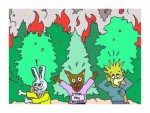There’s more to the maiden-mother-crone triumvirate of female experience. There’s actually a fourth stage of existence, just as there are four phases of the moon. You know, that new moon thing, the dark of the moon, the hidden moon, the unknown where all is night and nothingness.
I went on about Fear of Icky Girl Power a while back, which was an attempt to make sense of the senseless. You know, trying to understand the unknowable. I’m talking about not the conscious, or the subconscious or the unconscious—all matters that can be conceptualized and grasped on some level. But then there’s not just the infinite, but as a friend of mine once remarked, “the infinitely infinite”.
In practical terms we’re discussing the mer-she. That woman which is completely veiled by the shimmering scales of the unknown and unknowable. The other three forms of woman are veiled to various degrees but show some human side or character (crescent waxing, full, crescent waning). Not so the dark of the moon.
This is some serious bad girl stuff we’re talkin’. Associated with just about every bad thing you might imagine a woman capable of, because that’s all you can do—try to make associations. There’s good reason to be afraid; not saying you should be unafraid. But easy to project onto this unknown part of half the population, remain in ignorance, run and hide or try to overcompensate by subjugating and demeaning.
But all you’ll be doing is working out complexes on the other three parts of experience—half fears and mirages of the unconscious acted out by your own shadow, tortured by the rumblings of your fantasies at the back of your mind, or making stupid mistakes because you don’t have the waking tools to focus on day to day external reality. The unknown? Who knows?
It’s a futile absurdity, but that doesn’t mean we aren’t obligated to try. The bad girl pushes us into trouble, and that’s just what she’s a gunna do. So what if you can only guess, get hoofin’ it, sucker.
Difficult, because the numinous will materialize the unexpected for you. Hostile rip apart of face and scarred for life, nothing at all but your friends laughing at you and your story of it—whatever it was, or Hek you might just wake up in the living room missing your coccyx. What you thought you saw is also likely to disappear at your approach or never be found as be encountered.
You see a lot of movies based on encounters with this inexplicable experience. The Fog (mist full of vengeful zombies), The Thing (extra-terrestrial shapechanger), Prince of Darkness (hostile liquid with psychic powers), Killdozer (machine animating space energy), Nightmare at 37,000 feet (psychic, freezing slime), Bug (swarms of fiery mutant roaches), The Giant Spider Invasion (swarms of inter-dimensional spiders), Return Of The Living Dead (hazardous animating chemical), and so on.
The plots all tend to center around identifying and neutralizing hostile forces previously unknown to our experience. Maintenance of order through heroic action. There is something to be said about extraordinary agency for the preservation of the community. Stories that reinforce ideals of survival are useful. They do protect the collective psyche from possession by outside forces.
However, it can also serve to repress and stifle creative energies that might be better served towards adaptation. If you want to tap into survival talk to a bad girl. But if you want to see what’s been saving our collective butts seek out the biggest baddest girl of all.
I’m talking about the bad girl as supernal super-predator.
- Absorptive (Devouring)
Whatever you’ve got, she can take it and you as well
- Controlling (Possessive)
She assumes command of anything she touches
- Infectious (Unrestrained)
She goes everywhere and anywhere
- Exponential (Overbearing)
Her influence grows in size with time
- Tenacious (Stubborn)
She never takes no as an answer
- Disruptive (Difficult)
She inspires fear and confusion wherever she appears
- Collective (Conniving)
She is many, she is one
With qualities like that, she doesn’t need much else, does she? She knocks over tyrannosaurus rexes for lunch money and invalidates the insurance policies of entire communities on good days. On bad hair days she threatens all life on the planet!
The typical story throws in a hero (usually male) who discovers another quality of the ultra-bad girl: Invented Weakness (Labeling). The plot very often revolves around identifying and exploiting the way of thinking that will diss-empower (I play with words) this ultra-bad girl.
In some cases this just brings everything to a draw until the next sequel (In The Blob she gets frozen until next time). In others there is a defeat but the knowledge that it could happen again is in the background. Sometimes the attempt to stop the spread of the ultra-bad girl’s power only delays the inevitable and she returns even stronger (Return of the Living Dead has this kind of doomsday ending).
It could be that nature requires physical laws be followed and thus game-balance be maintained, but I can’t help but feel this is a human conceit. It’s in our interest to believe in ourselves as being special if it maintains survival.
I prefer to dispel that characteristic as illusion and suggest a possible other characteristic: Enjoys The Hunt (Capricious). We are never out of truth, and does not the bad girl hold a mirror up to ourselves? Girls just wanna have fun.
I wouldn’t consider the realities of these movies fun for the participants, but are they not shared imaginary spaces of a certain form, in which we invite the ultra-bad girl to come and play? To demonstrate to us her amazing power and give us insights into some of our deepest, most terrifying curiousities?
Who wants to be one of her victims? Would anyone possibly want to watch as she destroys all our feeble attempts at understanding, turning us into corpses at her command so that we might slay our loved ones?
Or rather, is there not something in all of us who finds that exciting and invigorating? She knows about life, and will teach us if we listen. Because remember, she lives out there beyond the unknown reaches of what can be conceived. Coming into our field of experience to scare the Hek out of us and inspire new ways of consciousness. Bad girl just wants us to come out and play—wanna get crushed, crumbled and chomped?
So hey! All you women out there: Become the bad girl you already are.
Even if it’s just throwing mushrooms in the soup because everyone but you hates them and pretending it was an accident if they even notice.
The supernal super-predator ultra-bad girl knows secrets. She’ll tell you one if you let yourself listen.
The End?



